Sewing your own clothes is fab. I have been making stuff for myself since I was ten years old. The first thing I made was a skirt and I have not looked back.
I love having something that nobody else has, in a style I like and in a fabric and a colour that I chose, and that fits properly. And I have fun in the process of making it!
When I started writing this post, I had planned for 10 tips. However, I thought of so many I ended up with 25 great tips for sewing clothes without a pattern!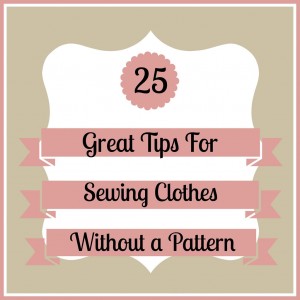
These tips for sewing your own clothes is what I have learnt from doing it myself. They are most relevant if you want to make stuff without using a pattern, but they may still be useful to you however you choose to go about your sewing.
I have included affiliate links.
25 Great Tips for Sewing Clothes Without a Pattern
1. Take your measurements and write them down somewhere, perhaps in your diary if you have one. Aside from the obvious measurements of bust, waist and hips, you might also consider taking measurements for:
- The distance between your shoulders
- The distance from your shoulder and your wrist
- The circumference of the top of your arm
- The circumference of your wrist
- Around your top half level with your armpits
- Your waist to your knee
- Your waist to your ankle
- Your waist to the length you like to wear skirts
If you are using a pattern you have bought, check your measurements against those on the back of the packet. The actual sizes often bear little resemblance to clothes you might buy on the high street, so checking the measurements is safest.
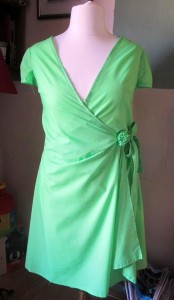 2. If you are going to be making your own clothes a lot, it might be worth investing in a tailors’ dummy. An adjustable one
2. If you are going to be making your own clothes a lot, it might be worth investing in a tailors’ dummy. An adjustable one is best, however non adjustable ones
are cheaper!
Another option would be to make your own tailors’ dummy out of duct tape. There are some great tutorials for doing just that on the internet. I found a lovely one at There’s a Dragon in My Art Room. Although Phyl (who wrote it) claims it’s not a tutorial, it kind of is. And it’s a good ‘un.
If you don’t want to/ can’t afford it/ don’t have space because you live in a little house that is disappearing under a mountain of fabric, it is possible to make your own clothes without one.
3. The clothes in your wardrobe are a good source of information. Have a look at how they are put together. If you have things that you don’t wear any more, you could take them apart. This will give you a sense of the size and shape of the pieces used to make them. You could even use the pieces as a pattern.
4. Another thing your existing clothes can tell you about is drape. How the fabric drapes depends partly on the fabric and partly on how it has been cut, whether on the grain or on the bias. To determine how the fabric has been cut, look at the way the woven threads run and see whether it stretches and if so, in which direction. Look at the fabric too, what it is made of and its thickness.
5. Make patterns from greaseproof paper,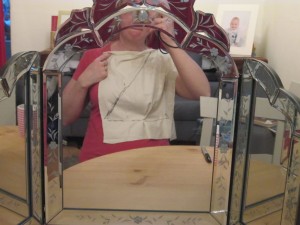 newspaper, pattern paper
newspaper, pattern paper or old fabric. Pin it to yourself to get an accurate sense of size. You can also use your existing clothes as patterns, especially if you are willing to take them apart.
6. When designing a garment, keep it simple. If I was going to make something complicated, I’d probably use a commercial pattern.
It’s the same with baking: if you know how to make a sponge cake, it’s easy enough to make a chocolate version, or a fruity version, or a lemon and lavender version.
Mmm, cake!
Anyway. If you know how clothes are put together in a basic way, it’s easy to make something simple. That’s not to say you can’t make anything fancy, just think of how you can make it look fab in the simplest way possible!
7. Take care when cutting out. When you are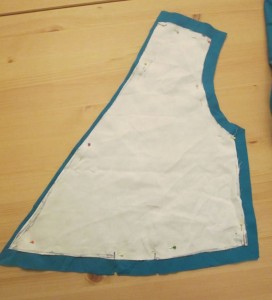 sewing your garment up, you will probably be following those edges you cut, so cut as neatly and as accurately as possible. It will make a difference to the finish of your outfit. It is worth shelling out for a decent pair of scissors. These
sewing your garment up, you will probably be following those edges you cut, so cut as neatly and as accurately as possible. It will make a difference to the finish of your outfit. It is worth shelling out for a decent pair of scissors. These are the ones that I use and they cut through fabric like a hot knife through butter.
8. Iron your fabric before you start. I’m very guilty of not doing this! However, it makes it easier to cut neatly and accurately. See #7 above!
9. Make sure you have enough fabric. It’s really annoying to start cutting out and find that you don’t have enough fabric, then wait around for the postman to bring you some more. My advice is to work out how much you need and check the width of the fabric you are buying as well as the length.
10. When laying out pattern pieces, check the direction of the grain. If you’re not sure, the grain runs parallel with the selvedges. Usually the grain will run vertically in tops and down the centre of skirts and trousers. When cutting out sleeves, the grain will need to run from shoulder to wrist.
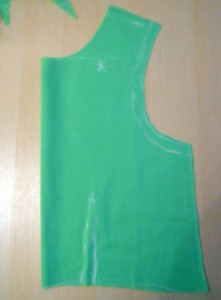 11. Allow enough! If you are unsure, make your pattern pieces and possibly your seam allowance slightly bigger. It’s easier to make things that are too large smaller than the other war round.
11. Allow enough! If you are unsure, make your pattern pieces and possibly your seam allowance slightly bigger. It’s easier to make things that are too large smaller than the other war round.
12. Finish raw edges with a zigzag stitch or an overlocker, or use French seams if the fabric looks like it might fray (you might like to read this post about finishing seams). You don’t want your hard work falling apart the first time you put it through the wash!
13. When choosing fabric, don’t be afraid of using jersey. Generally stretchy and/ or slinky fabric can be a nightmare to work with. However, some jerseys stretch less, making them easier to work with. Look for fabric with a 2 way stretch as it tends to hold its shape better. The advantage of using jersey is that you don’t need to bother with zips or darts because the fabric does that job for you!

14. Upcycle. Fabric can be expensive, so look around for things that you might use instead. There is a lot of fabric in a man’s shirt for example (as I have said before, that is especially true if the shirt belongs to a large man). There is enough fabric in them to make clothes for small children and, with some imagination, for adults too! Other potentially useful sources include tablecloths and duvet covers. If you don’t have anything suitable at home, raid the charity shops.
15. Check that you are using the most appropriate stitch for your fabric. Most decent sewing machines will have a stitch specifically for stretchy fabrics. It looks like a kind of wonky zigzag and it allows the fabric to be sewn without too much stretching or puckering. Also try not to stretch the fabric yourself while sewing.
16. Keep trying it on! Put the garment on inside out and if it needs altering, pin and mark with a pen or a piece of chalk, then adjust it as you need to.
17. Consider using tacking stitches instead of pins, especially for armpits and gathers. It’s no fun being jabbed in the armpit by a pin when you are trying something on.
18. Don’t be afraid of adding a zip.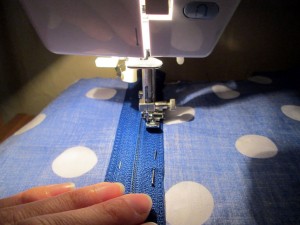 You might get away with not using them sometimes, but sooner or later you’ll probably make something that will need one. It doesn’t have to be difficult! I have a tutorial for adding a zip here. It is the easiest way I have found so far! If you don’t have a zip foot, it is worth buying one as it allows to you to sew closer to the zip, it’s easier and it all ends up looking much neater. Here is a linky for a zip foot.
You might get away with not using them sometimes, but sooner or later you’ll probably make something that will need one. It doesn’t have to be difficult! I have a tutorial for adding a zip here. It is the easiest way I have found so far! If you don’t have a zip foot, it is worth buying one as it allows to you to sew closer to the zip, it’s easier and it all ends up looking much neater. Here is a linky for a zip foot.
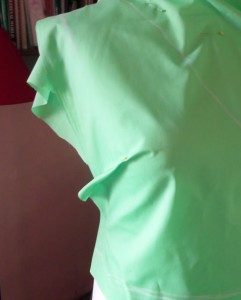 19. Do not fear darts. These are another potentially scary thing that always seem horribly confusing when following a commercial pattern. All they are is a little bit of fabric taken in in the shape of a triangle to give a thing a bit more shape. If you are making something and it seems a bit shapeless, add some darts and that should do the trick.
19. Do not fear darts. These are another potentially scary thing that always seem horribly confusing when following a commercial pattern. All they are is a little bit of fabric taken in in the shape of a triangle to give a thing a bit more shape. If you are making something and it seems a bit shapeless, add some darts and that should do the trick.
20. Trim and press seams as you go. When joining the pieces you will often have to sew over seams. It’s much easier if you have trimmed and pressed them already and your finished outfit will look neater.
21. Clip curves and cut off points. By making a series of small cuts in a curved seam, it will allow the curve to sit flat when you turn the thing the right way out.This is especially important to remember when making trousers.
22. Use bias binding to finish necklines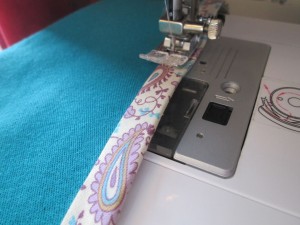 and arm holes. I have trouble with facings. I can never get them to stay on the inside. There is probably something I’m not doing right, but given a choice I’d rather not use them. Finishing them with bias binding is very easy and it looks much neater, at least on the stuff I’ve made! You might like to read this post about finishing necklines.
and arm holes. I have trouble with facings. I can never get them to stay on the inside. There is probably something I’m not doing right, but given a choice I’d rather not use them. Finishing them with bias binding is very easy and it looks much neater, at least on the stuff I’ve made! You might like to read this post about finishing necklines.
23. Get someone to help you with hems or use a tailors’ dummy. It can be difficult to get them level otherwise.
24. The unpicker is your friend. It’s much quicker than faffing about with a pair of scissors. I keep several handy because I’m always losing them!
25. If it all goes wrong, turn it into something else. I had a spotty dress that I made from a pattern that came free with a magazine. I checked my measurements and I kept trying it on, but when it was finished it looked awful. It was completely shapeless and the facing would not stay put. I made a belt for it and I wore it a couple of times, but it was awful and I knew I would never wear it again. So I turned it into a skirt! You can read about how I did that here!
What would your top tip for sewing clothes without a pattern be?
PS If you want to sew clothes without using a pattern, you might like my ebook!
If you like this post, you might also like:
A Simple Dress Without a Pattern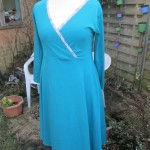
A Spring Green Wrap Dress Without a Pattern Cherry Blossom Dress Without a Pattern
Cherry Blossom Dress Without a Pattern How to Make a Circle Skirt
How to Make a Circle Skirt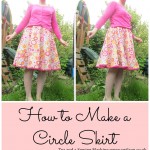


Your tips are fantastic.
Wow, these methods are so practical, it makes me feel that making a piece of clothing is very simple! I am going to make a new piece of clothing with felt, using the techniques you taught me, thank you!
25 tips for sewing without a pattern, except a lot of them are on how to make a pattern to sew with. I’m not saying that it wasn’t informative, it was, I liked tips 18-25, it just wasn’t what I was looking for…
I been wanted to learn how to make clothes for a long time you make it look simple
Thank you! It’s about having a go and not worrying too much if things don’t turn out quite as you expected x
Great tips. Thanks for sharing.
Thanks so much for your information l find it so useful am so grateful and would like to know how I can get a fairly used industrial sewing machine and embroidery machineAnd weaving machine my email [email protected]
This post is such a treasure! I’ve just begun my introduction to sewing via youtube tutorials and so far have made a pillow case and several tops (I’m having soo much with the learning process!). I haven’t the patience for learning to operate with patterns at this particular moment, however I do appreciate viewing/reading of sewing techniques. This post fits my current approach to clothing-making nicely. Thank you!
Glad you found it useful 🙂
Great post, thanks so much. This is my method for doing facings: after I’ve cut out the garment, I take the pattern piece off the fabric, then place the piece that needs a facing (the cut material without the pattern piece) back down on the material–making sure it’s on grain–then cut the armhole or neck and seam edges from that. Remove the garment piece, then measure the desired depth of the facing and finish cutting it out. For some reason this works. All I can think is that any distortion induced by cutting the fabric (even though I am very careful) is then reproduced on the facing, giving a better match.
Thanks Christine, I will definitely try this next time!
Excellent advice! I have sewn off and on over the years, but almost always with a patter, and my mother was a seamstress (much better than I), and I now live where I can’t buy patterns. Am looking forward to applying your suggestions!
Thank you 🙂
Great tips.I like the one about the darts.
Thanks, I hope they’re useful 🙂
Great tips! Thanks so much for sharing with us at #ondisplaythursday
Thanks 🙂
These are such great tips! I want to try my hand at making a midi skirt for myself soon. Thanks for sharing!
I hope you find the tips helpful 🙂
What a great post! Maybe I will dust off my sewing machine after all! xx
Go for it Louise!
I studied pattern design and cutting years and years ago and agree so much fun to make your own designs come to life
It definitely is!
Wow I am so glad I found you. I am about to do all the measuring bit. The last time I did this was at school. Your tips are fantastic.
Ali xx
I hope they’re helpful Ali.
Lots of great advice there, thanks for sharing.
Thanks, I’m hoping people will find it useful.